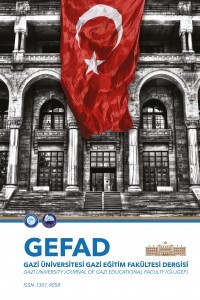Elektrik ve Manyetizma Konularında Anlaşılması Zor Kavramlar İçin Model Geliştirilmesi
Kavramsal Model, Zihinsel Model, Benzetme, Elektrik, Manyetizma.
Developing Models for Difficult and Abstract Concepts in Electrics and Magnetism
Conceptual Model, Mental Model, Comparison, Electrics, Magnetism,
___
- Cartıer, J., Rudolph, J. and Stewart, J. (2001). The Nature and Structure of Scientific Models. The National Center for Improving Student Learning and Achievement in Mathematics and Science (NCISLA), Working Paper.
- Dagher, Z. (1995). Review of Studies on the Effectiveness of Instructional Analogies in Science Education. Science Education, 79 (3), 295-312.
- Duphın, J. J. and S, Johsua, (1989). Analogies and “Modelling Analogies” in Teaching: Some Examples in Basic Electricity. Science Education, 73 (2), 207-224.
- Gılbert, S. (1989). An evaluation of the Use of Analogy, Simile and Metaphor in Science Texts. Journal of Research in Science Teaching, 26, 315-327.
- Greca, I. M. and Moreıra, M. A. (2000). Mental Models, Conceptual Models and Modelling. Instructional Journal Science Education, 22, 1-11.
- Greca, I. M. and Moreıra, M. A. (2001). Mental, Physical and Mathematical Models in the Teaching and Learning of Physics. Inc. Science Education, 86, 106-121.
- Günbatar, S., (2003). Fizik Eğitiminde Elekterik ve Manyetizma Konularındaki Anlaşılması Zor Kavramlar için Bodel ve Benzetme Geliştirilmesi. Yayımlanmış Yüksek Lisans Tezi. G.Ü. Eğitim Bilimleri Estitüsü, ANKARA
- Harrıson, A. G., Treagust, D. F. (1999). Learning about Atoms, Molecules and Chemical Bonds: A Case Study of Multiple- Model Use in Grade 11 Chemistry. Inc. Science Education, 84, 352-381.
- Harrıson, A. G. (2001). How to Teachers And Textbook Writers Model Scientific Ideas For Students. Research in Science Education, 31, 401-435.
- Lawson, D. and Lawson, A. (1993). Neural Principles of Memory and a Neural Theory of Analogical Insight. Journal of Research in Science Teaching, 30 (10), 1327-1348.
- Smıt, J. J. A. (1995). Models in Physics: Perceptions Held By Final Year Prospective Physical Science ,Teachers Studying at South African Universities. Instructional Journal Science Education, 17 (5), 621-634.
- Treagust, D. F., Chıttleborough, G. and Mamıala, T. L. (2002). Student’ s Understanding of The Role of Scientific Models in Learning Science. International Journal of Science Education, 24 (4), 357-368.
- Wosnıadou, S. and Schommer, M. (1998). Explanatory Analogies Can Help Children Acquire in Formation from Expository Text. Journal of Educational Psycology, 10, 524-536.
- ISSN: 1301-9058
- Yayın Aralığı: Yılda 3 Sayı
- Başlangıç: 1985
- Yayıncı: Gazi Üniversitesi
Öğrencilerin Sosyal Sorumluluklarının Geliştirilmesinde Öğretmenlerin Rolü
20. Yüzyılın Birinci Yarısında Alman Müzik Eğitimini Etkileyen Başlıca Oluşumlar Ve Okul Müzik Dersi
Elektrik ve Manyetizma Konularında Anlaşılması Zor Kavramlar İçin Model Geliştirilmesi
Teknik Öğretmen Yetiştirme Sorunu Ve Teknik Eğitim Fakültelerinin Geleceği
Müzik Öğretmenliği Mesleği Gerekleri Doğrultusunda Bir Armoni Eğitimi
Lütfullah TÜRKMEN, Osman ÇARDAK, Musa DIKMENLI
Üniversite Öğretim Elemanlarının Boş Zaman Alışkanlıklarını Değerlendirmeleri Üzerine Bir Araştırma
